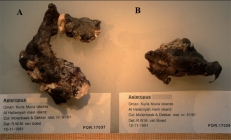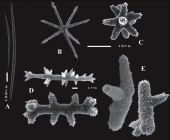 |
 |
|
|
||
Traits taxon detailsAsteropus moolenbeeki van Soest & Beglinger, 2008
380201 (urn:lsid:marinespecies.org:taxname:380201)
accepted
Species
marine,
recent only
Van Soest, R.W.M.; Beglinger, E.J. (2008). Tetractinellid and hadromerid sponges from the Sultanate of Oman. <em>Zoölogische Mededelingen Leiden.</em> 82 (53): 749-790. [details]
de Voogd, N.J.; Alvarez, B.; Boury-Esnault, N.; Cárdenas, P.; Díaz, M.-C.; Dohrmann, M.; Downey, R.; Goodwin, C.; Hajdu, E.; Hooper, J.N.A.; Kelly, M.; Klautau, M.; Lim, S.C.; Manconi, R.; Morrow, C.; Pinheiro, U.; Pisera, A.B.; Ríos, P.; Rützler, K.; Schönberg, C.; Turner, T.; Vacelet, J.; van Soest, R.W.M.; Xavier, J. (2024). World Porifera Database. Asteropus moolenbeeki van Soest & Beglinger, 2008. Accessed through: Marine Species Traits editorial board (2024) Marine Species Traits at: https://www.marinespecies.org/traits./aphia.php?p=taxdetails&id=380201 on 2024-09-21
Marine Species Traits editorial board (2024). Marine Species Traits. Asteropus moolenbeeki van Soest & Beglinger, 2008. Accessed at: https://marinespecies.org/traits/aphia.php?p=taxdetails&id=380201 on 2024-09-21
Date action by
original description
Van Soest, R.W.M.; Beglinger, E.J. (2008). Tetractinellid and hadromerid sponges from the Sultanate of Oman. <em>Zoölogische Mededelingen Leiden.</em> 82 (53): 749-790. [details]
 Present Present  Inaccurate Inaccurate  Introduced: alien Introduced: alien  Containing type locality Containing type locality
|


